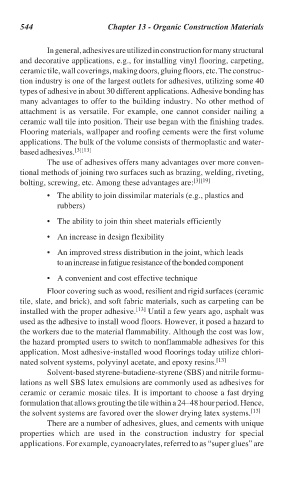Page 574 - Handbook of Thermal Analysis of Construction Materials
P. 574
544 Chapter 13 - Organic Construction Materials
In general, adhesives are utilized in construction for many structural
and decorative applications, e.g., for installing vinyl flooring, carpeting,
ceramic tile, wall coverings, making doors, gluing floors, etc. The construc-
tion industry is one of the largest outlets for adhesives, utilizing some 40
types of adhesive in about 30 different applications. Adhesive bonding has
many advantages to offer to the building industry. No other method of
attachment is as versatile. For example, one cannot consider nailing a
ceramic wall tile into position. Their use began with the finishing trades.
Flooring materials, wallpaper and roofing cements were the first volume
applications. The bulk of the volume consists of thermoplastic and water-
based adhesives. [3][13]
The use of adhesives offers many advantages over more conven-
tional methods of joining two surfaces such as brazing, welding, riveting,
bolting, screwing, etc. Among these advantages are: [3][19]
• The ability to join dissimilar materials (e.g., plastics and
rubbers)
• The ability to join thin sheet materials efficiently
• An increase in design flexibility
• An improved stress distribution in the joint, which leads
to an increase in fatigue resistance of the bonded component
• A convenient and cost effective technique
Floor covering such as wood, resilient and rigid surfaces (ceramic
tile, slate, and brick), and soft fabric materials, such as carpeting can be
installed with the proper adhesive. [13] Until a few years ago, asphalt was
used as the adhesive to install wood floors. However, it posed a hazard to
the workers due to the material flammability. Although the cost was low,
the hazard prompted users to switch to nonflammable adhesives for this
application. Most adhesive-installed wood floorings today utilize chlori-
nated solvent systems, polyvinyl acetate, and epoxy resins. [13]
Solvent-based styrene-butadiene-styrene (SBS) and nitrile formu-
lations as well SBS latex emulsions are commonly used as adhesives for
ceramic or ceramic mosaic tiles. It is important to choose a fast drying
formulation that allows grouting the tile within a 24–48 hour period. Hence,
the solvent systems are favored over the slower drying latex systems. [13]
There are a number of adhesives, glues, and cements with unique
properties which are used in the construction industry for special
applications. For example, cyanoacrylates, referred to as “super glues” are

